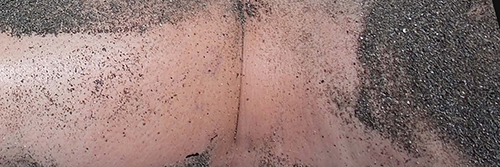Preston, Julieanna. granular gestures [video]. 2015.
I was invited to the land of black sand, the land of fiery stones, the land of peaceful resistance, the land and waters of some one else’s great great great great grandparents and a place of other people’s struggles past and present. This was an ominous affair. So I took my time driving up the coast along the surf highway, my car packed with veggies from my garden and a box of books that included Ian Wedde’s To Taranaki, Laura Levin’s Performing Ground, Witi Himera’s The Parihaka Women and The Real McKay by Graham Bishop. I stopped at every beach for a swim and, with slight ceremony, bought an ice cream, pie or piece of fruit in the first dairy of every town. I took note when the horizon to my right started to erupt as THE mountain that is so central to the region. A long day arriving.
Granular gestures is an assemblage of videos taken at the mouth of the Herekawa Stream at dawn at each of the seven days of the artist’s residency in New Plymouth. Un-staged, the videos represent a coming to terms with material place— its multi-dimensional blackness in relation to my persistent whiteness, its fluid and supple nature reorganising my senses, my aging body and its ancient body, its coarseness and proclivity to nest in every nook and cranny in contrast to my history of shifting often and not leaving a trace, its metallic gritty taste against my recently amalgam-free molars. It brought new meaning to being an immigrant with an impulse to blend in, as Laura Levin proposes, to perform ground. Performing ground is a performance strategy in which the human body co-mingles with or is presented as a direct extension of its setting. Contrary to the triumphant individualised subject and its assumed privilege, ownership and self-definition that sees ground as a low-life, no-life, dead and something to domineer over, the concept of performing ground experiments with gestures of blending in and other chameleon-like actions that figure camouflage as political critique of structures of visibility, as an emphatic response to the other and as an act of eco-activism. In my spatial practice, I add non-humans to that list of other bodies. This is not camouflage to hide nor mimicry to pretend; this is blending in the attempt to approach an other (different) body where there is a porosity of self to world, a closeness to world with respect for the other.




